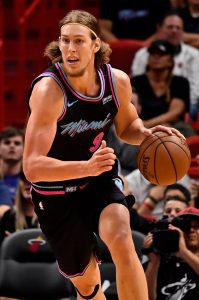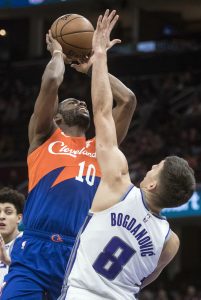While the NBA’s Collective Bargaining Agreement limits the flexibility teams have to sweeten their offers to free agents, one tool clubs have at their disposal is a trade kicker. Also known as trade bonuses, trade kickers represent extra cash a player can receive if his team trades him, and are often written into contracts for major free agent signings or extensions.
 Trade kickers can be represented in a fixed dollar amount or a percentage, or a combination of the two. For example, Kelly Olynyk‘s current contract with the Heat calls for a trade kicker worth the lesser amount of $2MM or 5% of his remaining salary.
Trade kickers can be represented in a fixed dollar amount or a percentage, or a combination of the two. For example, Kelly Olynyk‘s current contract with the Heat calls for a trade kicker worth the lesser amount of $2MM or 5% of his remaining salary.
Trade bonuses can’t exceed 15% of the player’s remaining salary. However, many of them are worth that maximum allowable amount. Currently, 18 of the 23 players with trade kickers have ones worth 15%.
[RELATED: NBA Players With Trade Kickers In 2018/19]
If a player with a 15% trade kicker has $10MM left on his contract and is traded, his bonus would be worth $1.5MM — 15% of $10MM. But the value of a trade kicker declines each passing day during the regular season, since the amount the player receives for the current year of his deal is prorated.
Here’s an example: Milos Teodosic is in the final year of his contract with the Clippers, earning a $6,300,000 salary with a 15% trade kicker. Technically, 15% of $6.3MM is $945K. However, 72 days of the 177-day regular season have already passed, so if Teodosic were traded today, his trade kicker would only apply to the 105 days remaining on his contract. He’ll make $3,737,288 during that stretch, so his 15% trade kicker would result in a bonus worth approximately $561K.
A trade kicker is paid by the team trading the player, and can only be paid out once during the player’s contract. For instance, Jeremy Lin had a trade bonus worth 10%, which he received when the Nets sent him to Atlanta during the 2018 offseason. If Lin is traded again by the Hawks, he wouldn’t get another trade bonus.
A pair of rules related to trade kickers have created some confusion about how the NBA would handle John Wall‘s 15% trade kicker if he’s traded this season. Those two rules are as follows:
- A player can’t receive his full trade bonus if it would take him over his maximum allowable salary. Stephen Curry, Gordon Hayward, and LeBron James are among the players currently earning max salaries who have 15% trade kickers — those bonuses would be voided if any of those players were traded this season.
- Note: A player can receive a portion of his trade bonus if his salary is worth less than the max and his bonus would take him over his max. This happened last season with Blake Griffin, whose partial bonus increased his salary to his max.
- Note: A player can receive a portion of his trade bonus if his salary is worth less than the max and his bonus would take him over his max. This happened last season with Blake Griffin, whose partial bonus increased his salary to his max.
- For cap purposes, a trade bonus is spread out over the remaining non-option years on a player’s contract. The exact dispersion depends on what percentage of each season’s salary is fully guaranteed. In basic terms though, if a player with a $3MM trade kicker has two guaranteed years left on his deal, $1.5MM would be applied to each season’s cap hit.
- Note: In that same scenario, if a player’s second season was only 50% guaranteed, $2MM of his trade kicker would be applied to the first year and $1MM to the second year, to reflect the guarantee proportions. If the player’s second season was non-guaranteed, the full $3MM bonus would hit the cap in year one.
- Note: In that same scenario, if a player’s second season was only 50% guaranteed, $2MM of his trade kicker would be applied to the first year and $1MM to the second year, to reflect the guarantee proportions. If the player’s second season was non-guaranteed, the full $3MM bonus would hit the cap in year one.
In Wall’s case, because he signed a super-max extension that goes into effect in 2019/20, he still has more than $180MM left on his contract, meaning a 15% trade bonus would be worth nearly $30MM. His salary for the 2018/19 season ($19,169,800) is well below his allowable maximum, so he should be eligible to receive that bonus. However, spreading the cap hits across five seasons would push his future salaries well above the max for those seasons, which isn’t allowed. It’s not clear how the NBA would handle that bonus if Wall is traded this season, since that specific situation has never arisen before.
A trade kicker can sometimes complicate salary matching in trades. Although the team trading away the player with the kicker pays the bonus money, that team still only counts the players’ original salary for matching purposes. However, the team acquiring the player must count his new cap figure for matching purposes.
For example, let’s say a player with three years and $30MM left on his contract ($10MM annual cap hits) has a 15% trade kicker. His bonus would work out to $4.5MM, which would be spread out across three seasons, adding $1.5MM to his current-year cap hit. The team acquiring him would view him as an $11.5MM player, while the team trading him would consider him a $10MM player. In some cases, that discrepancy can prevent a deal from working for one side from a salary-matching perspective.
In that scenario, the player is permitted to waive his trade bonus, clearing the way for a deal to work, but he’s under no obligation to do so. A player can waive his trade bonus for any other reason too, if he so chooses.
Here are several other rules related to trade kickers:
- Player and team options aren’t taken into account when calculating trade bonuses, but early termination options are.
- Only the base value of a contract is taken into account when calculating trade bonuses. Incentives aren’t considered.
- Trade kickers can technically be included in rookie contracts, but a player on a rookie deal can’t exceed 120% of his rookie scale amount via a trade bonus, so this is extremely rare.
- A minimum salary contract can include a trade bonus. If the bonus vests, the contract is no longer considered to be a minimum salary deal.
- If a player signs an extension, a trade bonus can be added to or removed from his contract.
Note: This is a Hoops Rumors Glossary entry. Our glossary posts will explain specific rules relating to trades, free agency, or other aspects of the NBA’s Collective Bargaining Agreement. Larry Coon’s Salary Cap FAQ was used in the creation of this post.
An earlier versions of this post was published in 2013 by Chuck Myron.
Photo courtesy of USA Today Sports Images.

 Alec Burks
Alec Burks